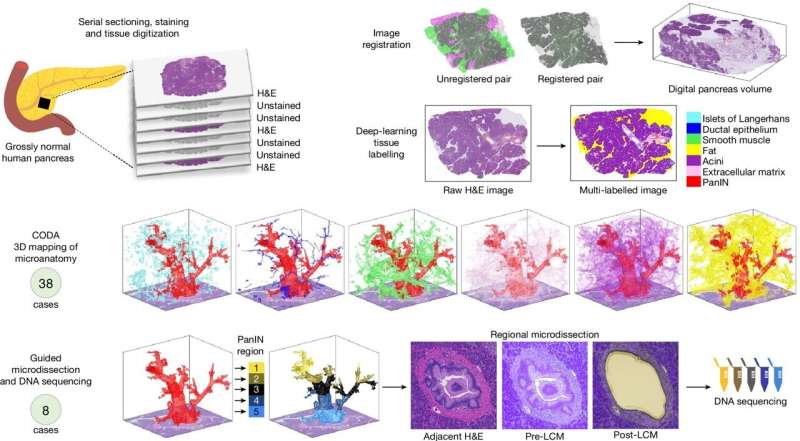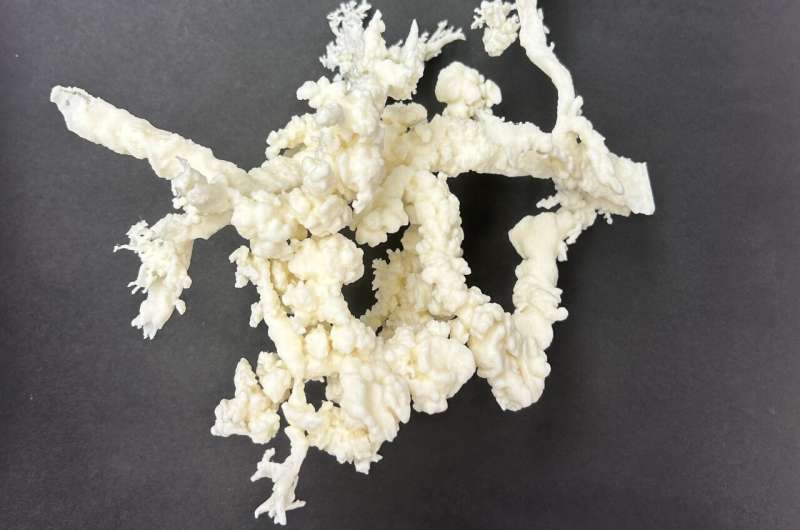This article has been reviewed according to Science X's editorial process and policies. Editors have highlighted the following attributes while ensuring the content's credibility:
fact-checked
peer-reviewed publication
trusted source
proofread
New 3D technique reveals precancerous pancreatic lesions

Researchers at the Johns Hopkins Kimmel Cancer Center's Sol Goldman Pancreatic Cancer Research Center have developed a 3D genomic profiling technique to identify small precancerous lesions in the pancreas—called pancreatic intraepithelial neoplasias (PanINs)—that lead to one of the most aggressive, deadly pancreatic cancers.
Published May 1 in Nature, the results provide the most detailed 3D map of precancerous lesions in the human pancreas to date, laying a foundation for future early detection of pancreatic ductal adenocarcinoma (PDAC) and other types of pancreatic cancer.
"Not many people actually develop pancreatic cancer, so we were shocked to find a lot of precancer, or PanINs, within the normal regions of the pancreas," says Laura Wood, M.D., Ph.D., associate professor of pathology and oncology at the Kimmel Cancer Center and the Johns Hopkins University School of Medicine and one of the study's senior authors. "This research highlights what we don't yet know about normal aging and raises fundamental questions about how cancer arises in the human pancreas."
The research was co-led by Alicia Braxton, D.V.M., Ph.D., a postdoctoral fellow at the Johns Hopkins University School of Medicine, and Ashley Kiemen, Ph.D., an assistant professor of pathology at the medical school.
Because of their small size, PanINs are challenging to detect and cannot be identified by a typical radiology examination. In the clinic, this often means that by the time patients are diagnosed with cancer, such as PDAC, the cancer already has reached an advanced stage and metastasized to other organs.
Existing 2D histological staining methods, during which tissue is thinly sliced, stained and examined under a microscope, provide only a limited view of PanINs, leaving researchers in the dark about their origins and how they lead to cancer. To better characterize PanINs, the researchers developed a 3D approach.
After thinly slicing and staining tissue from 38 normal pancreatic samples onto hundreds of sequential 2D slides, the researchers developed CODA, a machine-learning pipeline, to analyze and reconstruct the slide images into digital 3D images.
The 3D reconstructions revealed complex networks of interconnected PanINs with an average overall burden of 13 PanINs per cubic centimeter, and a range of from 1 to 31 PanINs per cubic centimeter. Patients with PDAC in other regions of their pancreas seemed to have a higher PanIN burden than those with nonductal disease, although it was not statistically significant.
The researchers further investigated eight of the samples via 3D-guided microdissection and DNA sequencing of specific PanINs. Genomic analysis revealed that the networks were made up of genetically distinct PanINs driven by different gene mutations, such as mutations in the cancer-causing gene Kirsten rat sarcoma virus (KRAS), which is found in most pancreatic cancers.

The finding that multiple precancerous lesions arose from independent mutations is something that hasn't yet been seen in other organs, says Wood, "but now that we know that PanINs are there, we can work on targeting them, such as through KRAS."
Although CODA is not yet usable in a diagnostic setting, among its advantages is that it can be applied to any tissue, disease or model organism, says Kiemen.
"This is just the beginning," she says. "We want to continue to investigate what this means in the context of other organ tissues. If normal tissue has thousands of PanINs, then how do we identify which ones are clinically relevant to disease and which ones are not?"
"One of the ways we can make a difference for the largest number of people with cancer is through prevention, and better understanding the early precursors to cancer through detailed and anatomic molecular maps is the first step," adds Wood. "Until you look in 3D, you don't know what you're missing."
More information: Alicia M. Braxton et al, 3D genomic mapping reveals multifocality of human pancreatic precancers, Nature (2024). DOI: 10.1038/s41586-024-07359-3

















